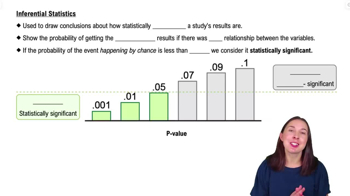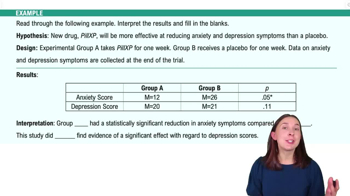Table of contents
- 1. Introduction to Psychology1h 43m
- 2. Psychology Research2h 20m
- 3. Biological Psychology2h 41m
- 4. Sensation and Perception28m
- 5. Consciousness and Sleep32m
- 6. Learning41m
- 7. Memory34m
- 8. Cognition37m
- 9. Emotion and Motivation35m
- 10. Developmental Psychology33m
- 11. Personality48m
- 12. Social Psychology41m
- 13. Stress and Health41m
- 14. Psychological Disorders44m
- 15. Treatment47m
2. Psychology Research
Evaluating Research Findings
Struggling with Psychology?
Join thousands of students who trust us to help them ace their exams!Watch the first videoMultiple Choice
Which of the following correlation coefficients indicates the strongest relationship between two variables?
A
r = + .25
B
r = + .55
C
r = - .10
D
r = - .65
 Verified step by step guidance
Verified step by step guidance1
Understand that the strength of a correlation is determined by the absolute value of the correlation coefficient, regardless of its sign.
Recall that correlation coefficients range from -1 to +1, where values closer to -1 or +1 indicate a stronger relationship.
Compare the absolute values of the given correlation coefficients: |+0.25|, |+0.55|, |-0.10|, and |-0.65|.
Identify which of these absolute values is the largest, as this will indicate the strongest relationship.
Conclude that the correlation coefficient with the largest absolute value represents the strongest relationship between the two variables.

 6:00m
6:00mWatch next
Master Descriptive Statistics – Measures of Central Tendency with a bite sized video explanation from Hannah Gordils
Start learningRelated Videos
Related Practice















![Ethical Guidelines in Psychology [AP Psychology Unit 1 Topic 6] (1.6)](https://img.youtube.com/vi/ilq2nGO7_QA/mqdefault.jpg)





























